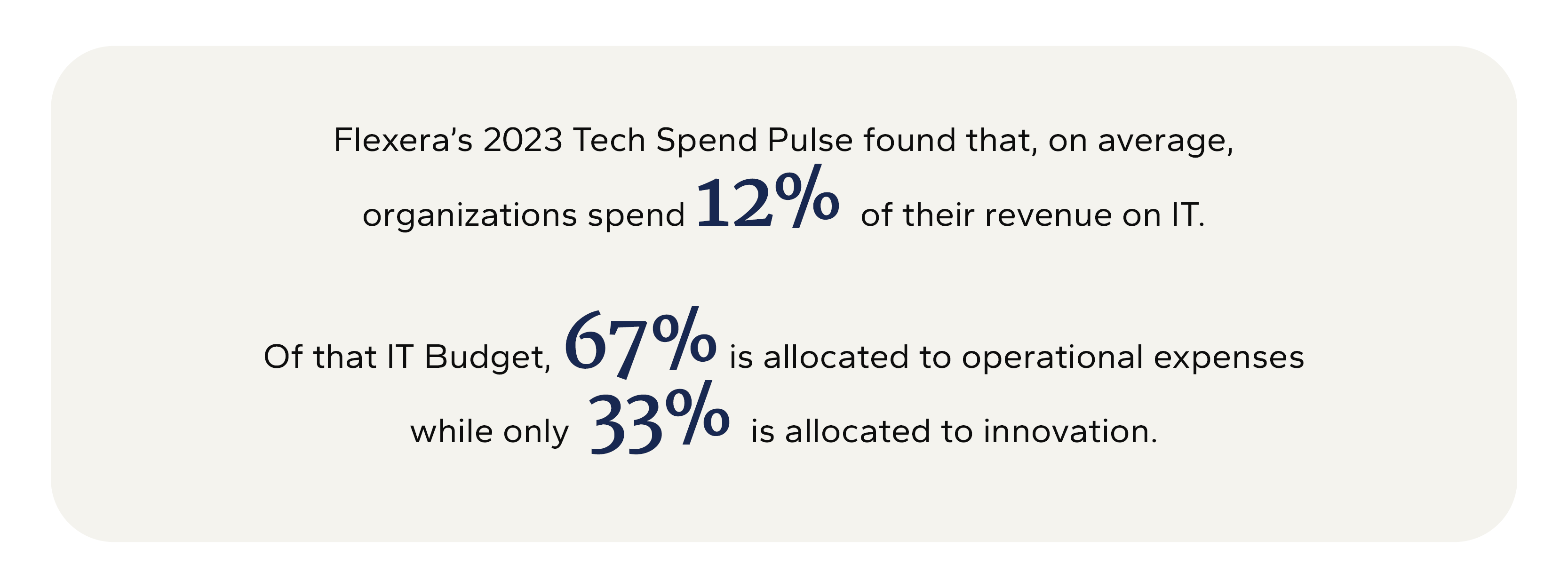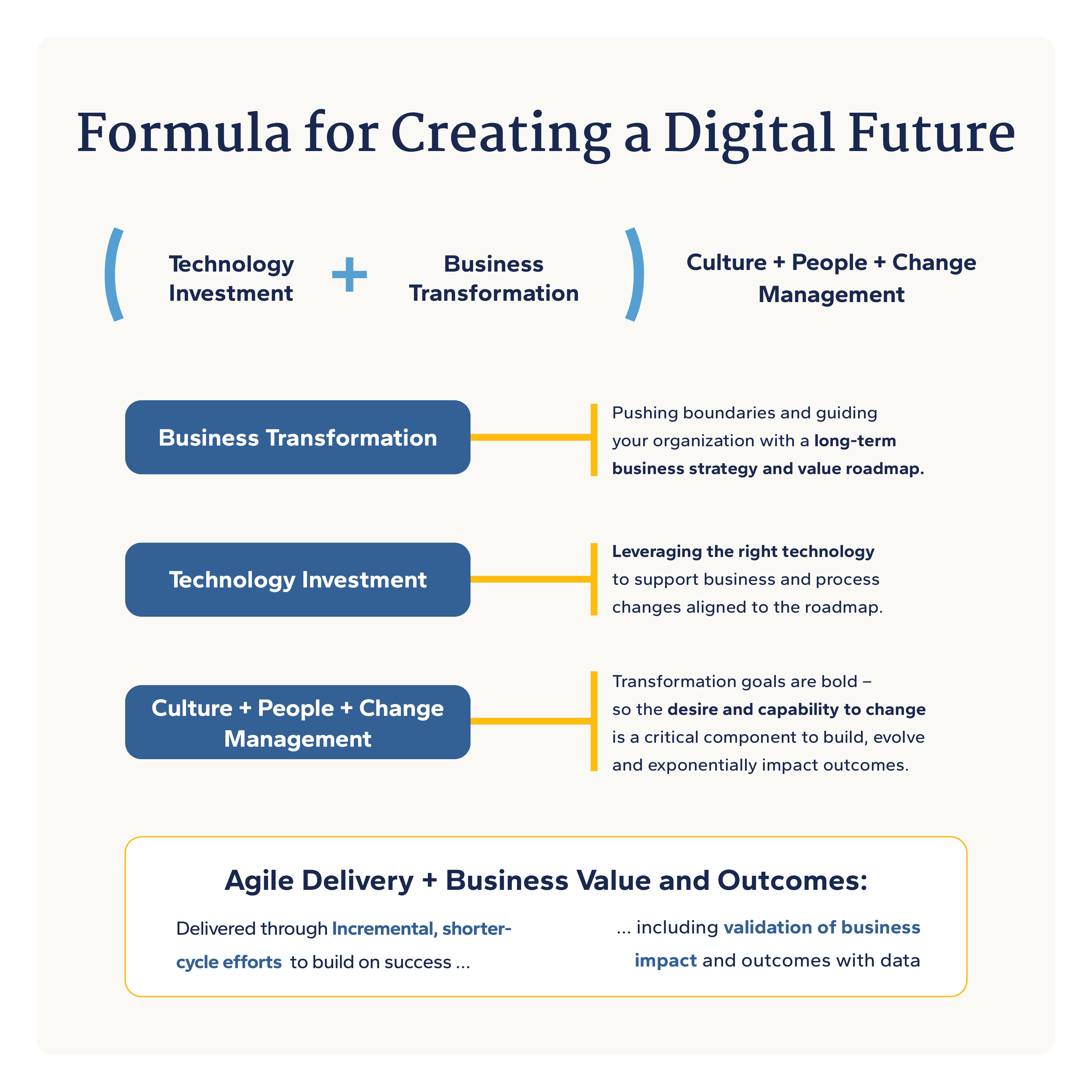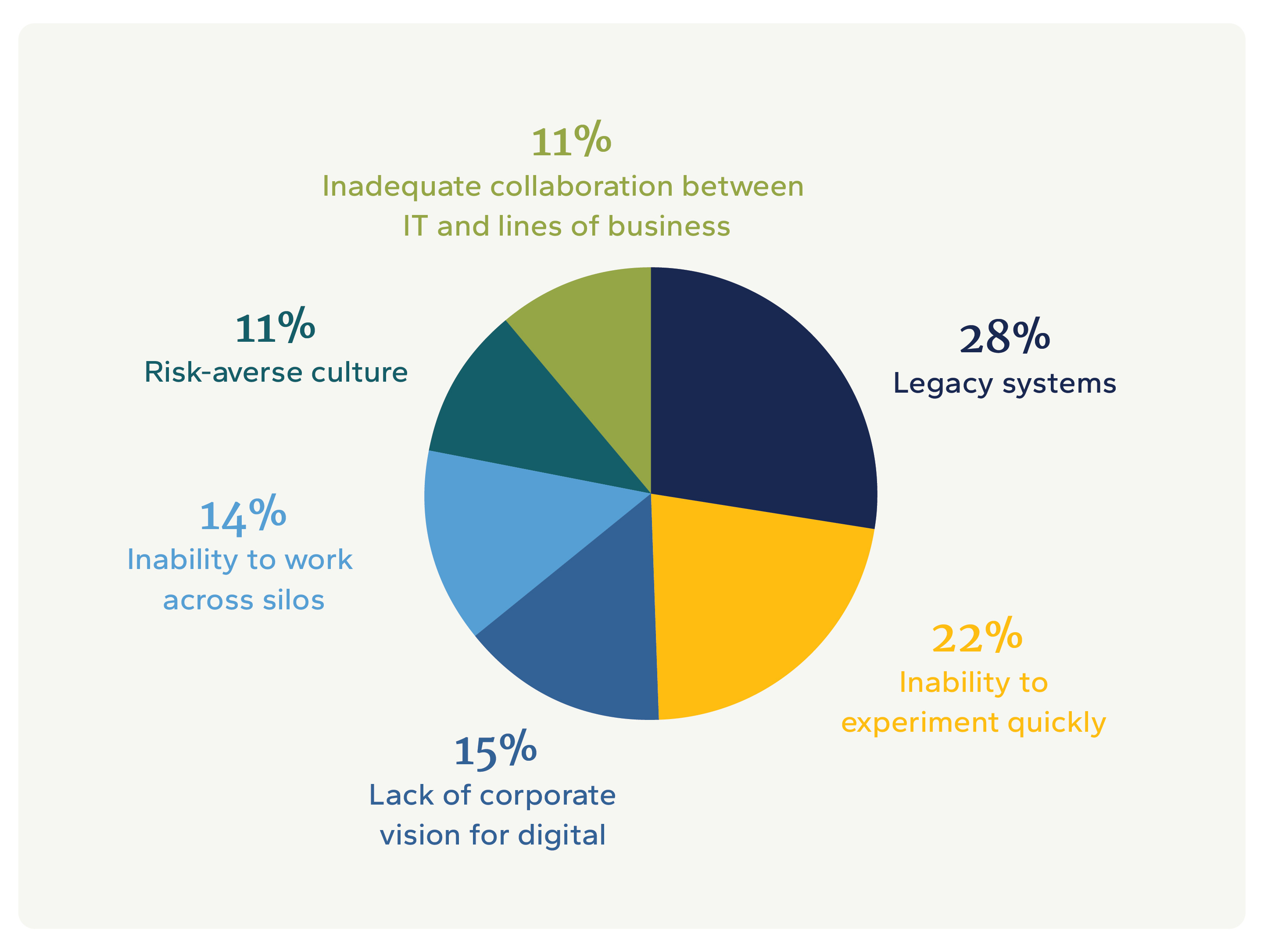Key Takeaways
- Distinguishing between operational expenses and transformational investments will help your organization better allocate its IT budget.
- Transformational initiatives aren’t like typical expenses with fixed costs and expectations, which means your transformation budget must be flexible and agile.
- Any transformational investment should create business value and align with a larger strategy.
When it comes to digital strategy, there’s incredible urgency. Customers expect digital, mobile, and cloud-based experiences; remote work requires cloud-based, use-anywhere tools for collaboration; and the power of analytics, artificial intelligence, and automation are quickly lifting competitors’ capabilities.
And here’s the reality: leaders in the digital and AI space are vastly outpacing other business leaders – at a rate of 60%.
Getting the maximum business value from your digital investments requires an understanding of operational and transformational IT spend and a plan that balances new implementations with smaller, iterative optimizations.
Operational vs. Transformational Technology Investments
Often, we see businesses lump their transformational investments in as operational expenses. This relegates your IT spend to categories that are too fixed for the purpose they serve and the cost structure they entail.
Understanding the difference in IT investments — and the importance of changing your budgeting perspective — will help you create a more successful, meaningful digital strategy.
Operational technology investments keep your business in shape day-in and day-out. They answer a need or fix a problem. They aren’t necessarily part of a larger business strategy — but they can be.
A transformational technology investment, however, is a technology or capability for your larger digital future. Each investment is attached to a long-term goal and is part of a strategy that fundamentally changes your business operations.

Types of Transformational Investments
Areas of focus should include:
![]() Agile Systems – Synchronized systems that enable you to deploy, respond, recover, and grow in a specified timeframe. For example, you’ll spend less time sitting on a project and more time reaping the rewards of having launched it. You’ll also be able to measure project performance and adjust as needed in a timely manner.
Agile Systems – Synchronized systems that enable you to deploy, respond, recover, and grow in a specified timeframe. For example, you’ll spend less time sitting on a project and more time reaping the rewards of having launched it. You’ll also be able to measure project performance and adjust as needed in a timely manner.
![]() Data & AI – A data ecosystem provides real-time decision making and allocates resources through intelligent automation. An integrated infrastructure for organization, storage, and reporting lays the foundation for maximizing the value of generative AI.
Data & AI – A data ecosystem provides real-time decision making and allocates resources through intelligent automation. An integrated infrastructure for organization, storage, and reporting lays the foundation for maximizing the value of generative AI.
![]() Cloud Infrastructure – When operations, functions, and data are hosted in a cloud environment, they are accessible from any location via an access-approved device and internet connection. Top cloud providers offer a high level of security and IT support, reducing the IT burden. You may choose to maintain a certain level of functionality on-premises, resulting in a hybrid cloud infrastructure.
Cloud Infrastructure – When operations, functions, and data are hosted in a cloud environment, they are accessible from any location via an access-approved device and internet connection. Top cloud providers offer a high level of security and IT support, reducing the IT burden. You may choose to maintain a certain level of functionality on-premises, resulting in a hybrid cloud infrastructure.
![]() Hybrid Work Capabilities – Companies need to ensure their employees can work securely from anywhere. Secure communication and collaboration capabilities, as well as tools and data, are all essential components.
Hybrid Work Capabilities – Companies need to ensure their employees can work securely from anywhere. Secure communication and collaboration capabilities, as well as tools and data, are all essential components.
The Cost of Digital Modernization
Transformational initiatives aren’t like typical capital or operational expenses with fixed costs and expectations. Your digital strategy might call for a sizeable upfront investment, strategic investments over time, or monthly costs that fluctuate based on your needs.
The cost of digital modernization depends on your organization’s needs. It also depends on how you phase your journey and how broad or narrow your focus area is. You might optimize your existing data infrastructure in phase one and implement a new ERP in phase two; you might focus on one division or the entire organization.
Your transformation budget must be flexible and agile, using new key performance indicators, along with traditional ones, to measure success.
- Watch our panel discussion to hear how two of our clients have navigated the different approaches to technology investment.
Making Transformative Decisions for Your Business and Budget
Business value defines what an outcome of digitally modernizing will look like for you.
This means having a plan for where you want to go and being thoughtful about why and how. It means looking at your individual investments as part of a whole. Will this new, trending widget only solve a near-term solution when you could otherwise invest in three smaller, less glamorous optimizations that will improve your business for the long term?
We’ve developed a digital future formula that combines your business transformation, or expected outcomes, with the technology investment — multiplied by culture, people, and change management. It’s the force of this multiplication that drives meaningful change.

Tips for Getting Started on Strategy
But how do you get started? Our recent survey found the most significant obstacles are legacy systems, inability to experiment quickly, a lack of corporate vision for digital, an inability to work across silos, a risk-averse culture, and inadequate collaboration between IT and lines of business.

In order to help address and overcome these obstacles, it’s important to be intentional about your current state and where you’re hoping to go.
Here’s how:
- Ensure your investments align with your organizational goals.
- Prioritize investments based on your roadmap, making sure you’re transforming and optimizing where it will matter most.
- Don’t settle for lower-cost options — choose the best solutions for your organization.
- Prepare to make the case for your investments and goals with data and roadmaps.
- Let your actual business needs and goals drive your choices, as opposed to trends and benchmarks in the industry.
- Determine relevant KPIs to measure the success of your initiatives. Measuring success will be different for every business.
- Develop a plan to facilitate change management at your organization — both initially and continually into the future.
- Ensure you have the right sponsorship within the organization.
Simply running the daily operations won’t suffice in today’s business environment. Allocating resources toward strategic, long-term digital success is essential for staying competitive.
Unlock Opportunity with a 360°Assessment

Strategy and Digital Future
Create a lasting digital future for your organization.
Who We Are
Eide Bailly is a CPA firm bringing practical expertise in tax, audit, and advisory to help you perform, protect, and prosper with confidence.



